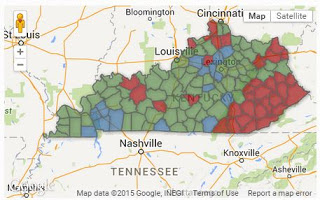Newspapers’ data analysis finds that Kentucky’s seniors on Medicare are among the sickest in U.S.; local data available

 |
| Red counties are over 21%. For map with data, click here. |
The top 10 Kentucky counties with the highest percentage of seniors on Medicare who have six or more chronic conditions are also in the nation’s top 50 for sick seniors, according to government data analyzed by USA Today and The Courier-Journal. Nine of the top 10 counties are in Appalachia.
“That’s not surprising,” Fran Feltner, director of the University of Kentucky Center of Excellence in Rural Health, told The C-J’s Laura Ungar. “And when you’re having breathing problems, high blood pressure problems and other problems, to me it seems like you’re waging a daily battle against the chronic diseases. It’s hard to fight the battle … and as you get older, it’s harder.”
The top 10 Kentucky counties ranked by percentage of the 65-and-older Medicare population with six or more chronic conditions are Clay, 27.1 percent; Breathitt, 26.3 percent; Johnson, 26.2 percent; Knott, 25.1 percent; Perry, 24.6 percent; Letcher, 24.2 percent; Bell, 24 percent; Floyd, 23.8 percent; Wolfe, 23.7 percent; and Taylor, 23.6 percent. Taylor County (Campbellsville) is not in Appalachia but borders three non-coal Appalachian counties.
 |
| Beve Cotton (C-J photo by Mark Mahan) |
“I’m a mess,” said Cotton, who gets around in a power chair and wears a full set of dentures after losing all his teeth. “I’m not able to do things. I’m an accomplished cook, but I can’t do that anymore … I can’t drive. My legs don’t cooperate. … It’s very hard.”
Ungar reports that Clay County, population 21,147, has many of the factors that combine to cause poor health.: “Nearly 38 percent of residents live below the poverty level, compared with a state average of 19 percent, according to the Census Bureau. Median household income is about $22,000 a year, about half the state average.Access to health care, especially specialists, is limited, and there are few well-stocked grocery stores or safe places to exercise. Smoking and obesity rates are sky-high.”
Carmen Webb, who directs the senior center in Manchester, told Ungar that many seniors struggle with being able to afford staples, let alone healthy food and also the high cost of transportation, making it difficult to get to doctors appointments to manage their illnesses.
Cotton, who grew up in Manchester, told Ungar that he depends on others for rides, frequently to doctors’ appointments, including many at the Veterans Affairs Medical Center in Lexington, about 100 miles away. Webb noted that public transportation in the area costs $1.50 per mile.
Feltner added that many seniors in the area don’t know how to prevent chronic disease, some have fatalistic attitudes and because many of them are on multiple medications, they face the dangers of drug interactions and side effects, Ungar reports.
Experts say that such high levels of illness hurts communities, “hastening a downward economic spiral locally and requiring huge portions of Medicare budgets,” Ungar writes. It also overtaxes the medical communities in rural counties even thinner.
“These patients need to be seen frequently by doctors, and they need much longer visits. … These folks need intense care,” Dr. Michael Karpf, executive vice president for health affairs at UK, told Ungar. “Given the shortage of primary care in Appalachia, this kind of patient just exacerbates that shortage.”
“The real issue is prevention — weight control, exercise, food habits,” Karpf said. “But it’s hard. Fast food is cheaper than wholesome, healthy food, and (the way people eat) is partly cultural. Those things are hard to change. It’s a generational process.”